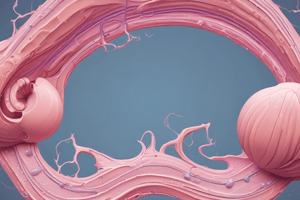Podcast
Questions and Answers
What type of cells are specialized to contain muscle fibers?
What type of cells are specialized to contain muscle fibers?
- Nerve cells
- Muscle cells (correct)
- Connective tissue cells
- Epithelial cells
What is the process of muscle development called?
What is the process of muscle development called?
- Muscle cell differentiation
- Myogenesis (correct)
- Muscle fiber formation
- Myofibrilogenesis
At what stage of prenatal development are loose connective tissue cell regions and compact myogenic cell regions visible in the human embryo?
At what stage of prenatal development are loose connective tissue cell regions and compact myogenic cell regions visible in the human embryo?
- Day 21
- Day 50
- Day 28
- Day 43 (correct)
By what day is the general organization of major muscles and bones essentially complete in the human embryo?
By what day is the general organization of major muscles and bones essentially complete in the human embryo?
What is the percentage of mononucleated cells in the gastrocnemius muscle by day 72?
What is the percentage of mononucleated cells in the gastrocnemius muscle by day 72?
What type of muscle fibers are present in the gastrocnemius muscle by day 62?
What type of muscle fibers are present in the gastrocnemius muscle by day 62?
What percentage of mononucleated cells are present by day 95 in the development of skeletal muscles?
What percentage of mononucleated cells are present by day 95 in the development of skeletal muscles?
Which type of muscle is found in the digestive system?
Which type of muscle is found in the digestive system?
What is the primary function of muscles in the body?
What is the primary function of muscles in the body?
During muscle development, what happens to myoblasts?
During muscle development, what happens to myoblasts?
What type of muscle is the heart muscle?
What type of muscle is the heart muscle?
When does muscle development occur?
When does muscle development occur?
Flashcards
Mother System Bio (Muscle Development)
Mother System Bio (Muscle Development)
The development of the muscular system, especially muscle cells, which are responsible for movement and other essential functions.
Muscle Cells
Muscle Cells
Specialized cells containing muscle fibers that enable movement and essential bodily functions.
Myogenesis
Myogenesis
The process of muscle development originating in the embryonic mesoderm.
Myofibers
Myofibers
Signup and view all the flashcards
Smooth Muscles
Smooth Muscles
Signup and view all the flashcards
Myocardium
Myocardium
Signup and view all the flashcards
Myoblasts
Myoblasts
Signup and view all the flashcards
Smooth Muscle Control
Smooth Muscle Control
Signup and view all the flashcards
Muscle Functions
Muscle Functions
Signup and view all the flashcards
Study Notes
The mother system bio focuses on the development of the muscular system, particularly muscle cells. Muscle cells are specialized cells that contain muscle fibers, which are responsible for movement and other essential functions in the body. Myogenesis, the process of muscle development, originates in cells of the embryonic mesoderm and follows a similar course in all species studied.
During prenatal development, myogenesis occurs through the formation of multinucleated myofibers, which are the precursors of muscle fibers. In the human embryo, no apparent organization is noted in the limb mesoderm on day 28 of development, but by day 43, loose connective tissue cell regions and compact myogenic cell regions are visible. By day 45, the first small multinucleated myotubes have formed, and by day 50, the general organization of major muscles and bones is essentially complete.
Fiber formation continues after birth, with the rate varying between and within individual muscles. For example, in the gastrocnemius muscle, well-developed, myofibril-containing muscle fibers are present by day 62, but the majority of cells are still mononucleated. By day 72, the population of mononucleated cells has decreased to about 50 percent of the total, while fibers have increased two- to threefold. During the next 2 weeks, fiber formation proceeds rapidly, with the percentage of mononucleated cells diminishing to 20 percent by day 95 and further decreasing to the point that only a few single cells persist in association with fibers by day 146.
In addition to skeletal muscles, the body also contains smooth muscles, which are at work in the digestive system, bladder, and eyes. Smooth muscles are involuntary and contract and relax in response to hormones and other signals. The heart muscle, or myocardium, is also an example of a smooth muscle that works autonomously, contracting to pump blood out and relaxing to let blood back in.
In summary, muscle development is a complex and dynamic process that involves the formation of multinucleated myofibers from mononucleated myoblasts, which withdraw from the cell cycle, fuse, and initiate the synthesis of muscle-specific proteins. This process occurs throughout prenatal development and continues into postnatal life, with different rates of fiber formation between and within individual muscles. Muscles are essential for movement and contribute to other functions such as posture, joint stability, and heat production.
Studying That Suits You
Use AI to generate personalized quizzes and flashcards to suit your learning preferences.




